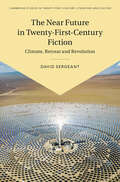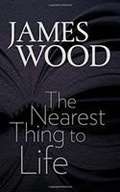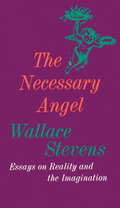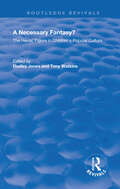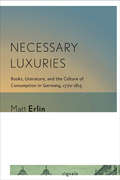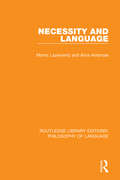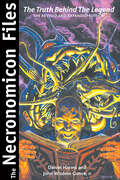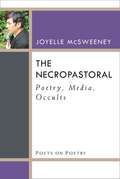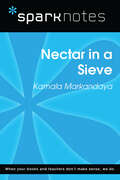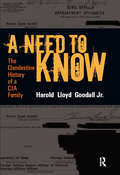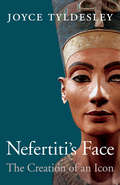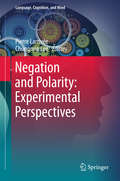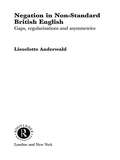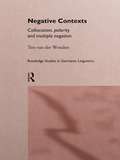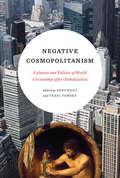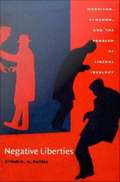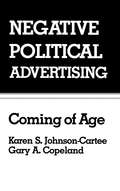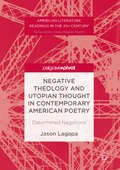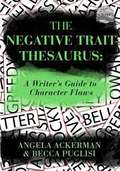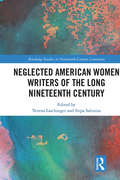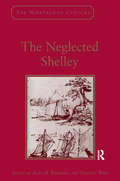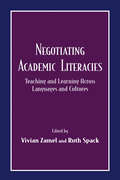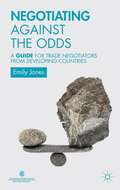- Table View
- List View
The Near Future in Twenty-First-Century Fiction: Climate, Retreat and Revolution (Cambridge Studies in Twenty-First-Century Literature and Culture)
by David SergeantA growing awareness of climate change and looming planetary crisis has put unprecedented pressure on the near future, leading to an increasing amount of fiction being set there. But what do these disparate works have in common, other than their temporal setting? And what can the imagination of the near future tell us about where we live now? The Near Future in 21st Century Fiction ranges across novels and films to reveal how our contemporary near future splits between two divergent paths. One seeks to retreat from climate change and the disruption it threatens to affluent lifestyles; the other tries to imagine new forms of community, and radical change, but struggles to locate a genre adequate to the task. It in this struggle, however, that we begin to glimpse the outlines of an emergent near future form: a revolution fit for the Anthropocene.
The Nearest Thing To Life (The Mandel Lectures In The Humanities At Brandeis University Series)
by James WoodIn this remarkable blend of memoir and criticism, James Wood, noted contributor to the New Yorker, has written a master class on the connections between fiction and life. He argues that, of all the arts, fiction has a unique ability to describe the shape of our lives and to rescue the texture of those lives from death and historical oblivion. <P><P>The act of reading is understood here as the most sacred and personal of activities, and there are brilliant discussions of individual works - among others, Chekhov's story "The Kiss," W.G. Sebald's The Emigrants, and Penelope Fitzgerald's The Blue Flower. Wood reveals his own intimate relationship with the written word: we see the development of a provincial boy growing up in a charged Christian environment, the secret joy of his childhood reading, the links he makes between reading and blasphemy, or between literature and music. The final section discusses fiction in the context of exile and homelessness. <P><P>The Nearest Thing to LifeÊis not simply a brief, tightly argued book by a man commonly regarded as our finest living critic - it is also an exhilarating personal account that reflects on, and embodies, the fruitful conspiracy between reader and writer (and critic), and asks us to reconsider everything that is at stake when we read and write fiction.
The Necessary Angel
by Wallace StevensThe Necessary Angel by Wallace Stevens"In this book, the first collection of his prose works, he accounts in scintillating language for the peculiarly modern and sometimes deliquescent fervor that has prompted his poems. Few poets have written so characteristically about their own craft." --Perspective--U.S.A."These are rich essays, simply constructed yet richly and elegantly written." --Hayden Carruth, The Nation"The most welcome attribute of the book is its humane good sense, equally manifest whether Stevens is discussing a desolate Pennsylvania churchyard. Plato's images or the personalities of those who prefer a drizzle in Venice to a hard rain in Hartford.''' --New Republic"It is a rare pleasure to breathe the atmosphere of confidence and wholeness which distinguishes the world of Wallace Stevens. Here we are refreshed by certainty without fragmentariness, by joyous possibilities without dishonesty. Here we find a moral and philosophical center through which reality may be repossessed and re-created with each new poetic act." --C. Roland Wagner, The Hudson Review
A Necessary Fantasy?: The Heroic Figure in Children's Popular Culture
by Dudley Jones Tony WatkinsThis book addresses a variety of issues through the examination of heroic figures in children's popular literature, comics, film, and television.
Necessary Luxuries: Books, Literature, and the Culture of Consumption in Germany, 1770–1815
by Matt ErlinThe consumer revolution of the eighteenth century brought new and exotic commodities to Europe from abroad--coffee, tea, spices, and new textiles to name a few. Yet one of the most widely distributed luxury commodities in the period was not new at all, and was produced locally: the book. In Necessary Luxuries, Matt Erlin considers books and the culture around books during this period, focusing specifically on Germany where literature, and the fine arts in general, were the subject of soul-searching debates over the legitimacy of luxury in the modern world.Building on recent work done in the fields of consumption studies as well as the New Economic Criticism, Erlin combines intellectual-historical chapters (on luxury as a concept, luxury editions, and concerns about addictive reading) with contextualized close readings of novels by Campe, Wieland, Moritz, Novalis, and Goethe. As he demonstrates, artists in this period were deeply concerned with their status as luxury producers. The rhetorical strategies they developed to justify their activities evolved in dialogue with more general discussions regarding new forms of discretionary consumption. By emphasizing the fragile legitimacy of the fine arts in the period, Necessary Luxuries offers a fresh perspective on the broader trajectory of German literature in the late eighteenth and early nineteenth century, recasting the entire period in terms of a dynamic unity, rather than simply as a series of literary trends and countertrends.
Necessity and Language
by Morris Lazerowitz Alice AmbroseThe problem of necessity remains one of the central issues in modern philosophy. The authors of this volume, originally published in 1985, developed a new approach to the problem, which focusses on the logical grammar of necessary propositions. This volume gathers their seminal essays on the problem of necessity, together with new material at the original time publication.
Necromanticism
by Paul WestoverNecromanticism is a study of literary pilgrimage: readers' compulsion to visit literary homes, landscapes, and (especially) graves during the long Romantic period. The book draws on the histories of tourism and literary genres to highlight Romanticism's recourse to the dead in its reading, writing, and canon-making practices.
The Necronomicon Files: The Truth Behind The Legend
by Daniel Harms John Wisdom Gonce IIIOccult scholars explore how H. P. Lovecraft’s fictional book of magic became a cultural phenomenon and real-life legend in this revised and expanded volume.What if a book existed that revealed the answers to all of life’s mysteries? For those who believe in it, The Necronomicon is exactly that—an eighth-century occult text of immense power. In. fact, The Necronomicon is a creation of science fiction writer H. P. Lovecraft, who referred to the work in a number of stories and gave weight to its legend by inventing its own elaborate history.In The Necronomicon Files two occult authorities explore all aspects of The Necronomicon, from its first appearance in Lovecraft’s fiction to its ongoing pervasive appearance in cult and occult circles. The authors show how Lovecraft’s literary circle added to the book’s legend by referring to it in their own writing. As people became convinced of the book’s existence, references to it in literature and film continue to grow. This revised and expanded edition also examines the lengths people have undergone to find the Necronomicon, and the cottage industry that has arisen in response to the continuing demand for a book that does not exist. The Necronomicon Files illuminates the transformations of a modern myth, exposing a literary hoax while celebrating the romance of Necronomicon lore.
The Necropastoral: Poetry, Media, Occults
by Joyelle McsweeneyIn The Necropastoral: Poetry, Media, Occults, poet Joyelle McSweeney presents an ecopoetics and a theory of Art that reflect such biological principles as degradation, proliferation, contamination, and decay. In these ambitious, bustling essays, McSweeney resituates poetry as a medium amid media; hosts "strange meetings" of authors, texts, and artworks across the boundaries of genre, period, and nation; and examines such epiphenomena as translation, anachronism, and violence. Through readings of artists as diverse as Wilfred Owen, Andy Warhol, Harryette Mullen, Roberto Bolaño, Aimé Césaire, and Georges Bataille, The Necropastoral shows by what strategies Art persists amid lethal conditions as a spectacular, uncanny force.
Nectar in a Sieve (SparkNotes Literature Guide Series)
by SparkNotesNectar in a Sieve (SparkNotes Literature Guide) by Kamala Markandaya Making the reading experience fun! Created by Harvard students for students everywhere, SparkNotes is a new breed of study guide: smarter, better, faster. Geared to what today's students need to know, SparkNotes provides: *Chapter-by-chapter analysis *Explanations of key themes, motifs, and symbols *A review quiz and essay topicsLively and accessible, these guides are perfect for late-night studying and writing papers
A Need to Know: The Clandestine History of a CIA Family
by H.L. Goodall JrIn scenes eerily parallel to the culture of fear inspired by our current War on Terror, A Need to Know explores the clandestine history of a CIA family defined, and ultimately destroyed, by their oath to keep toxic secrets during the Cold War. When Bud Goodall’s father mysteriously died, his inheritance consisted of three well-worn books: a Holy Bible, The Great Gatsby, and a diary. But they turned his life upside down. From the diary Goodall learned that his father had been a CIA operative during the height of the Cold War, and the Bible and Gatsby had been his codebooks. Many unexplained facets of Bud’s childhood came into focus with this revelation.The high living in Rome and London. The blood-stained stiletto in his jewelry case. Bud, as a child, was always told he never had “a need to know.” Or did he? Now, as an adult and a university professor, Goodall attempts to fill in the missing pieces of his Cold War childhood by uncovering a lifetime of family secrets. Who were his parents? What did his father do on those business trips when he was “working for the government?” What betrayal turned a heroic career of national service into a nightmare of alcoholism, depression, and premature death for both of his parents? Slowly, inexorably, Goodall unearths the chilling secrets of a CIA family in A Need to Know. 2006 Best Book Award, National Communication Association Ethnography Division
Nefertiti’s Face: The Creation of an Icon
by Joyce TyldesleyLittle is known about Nefertiti, the Egyptian queen whose name means “a beautiful woman has come.” She was the wife of Akhenaten, the pharaoh who ushered in the dramatic Amarna Age, and she bore him at least six children. She played a prominent role in political and religious affairs, but after Akhenaten’s death she apparently vanished and was soon forgotten. Yet Nefertiti remains one of the most famous and enigmatic women who ever lived. Her instantly recognizable face adorns a variety of modern artifacts, from expensive jewelry to cheap postcards, t-shirts, and bags, all over the world. She has appeared on page, stage, screen, and opera. In Britain, one woman has spent hundreds of thousands of pounds on plastic surgery in hope of resembling the long-dead royal. This enduring obsession is the result of just one object: the lovely and mysterious Nefertiti bust, created by the sculptor Thutmose and housed in Berlin’s Neues Museum since before World War II. In Nefertiti’s Face, Egyptologist Joyce Tyldesley tells the story of the bust, from its origins in a busy workshop of the late Bronze Age to its rediscovery and controversial removal to Europe in 1912 and its present status as one of the world’s most treasured artifacts. This wide-ranging history takes us from the temples and tombs of ancient Egypt to wartime Berlin and engages the latest in Pharaonic scholarship. Tyldesley sheds light on both Nefertiti’s life and her improbable afterlife, in which she became famous simply for being famous.
Negation and Polarity: Experimental Perspectives
by Pierre Larrivée Chungmin LeeThis volume offers insights on experimental and empirical research in theoretical linguistic issues of negation and polarity, focusing on how negation is marked and how negative polarity is emphatic and how it interacts with double negation. Metalinguistic negation and neg-raising are also explored in the volume. Leading specialists in the field present novel ideas by employing various experimental methods in felicity judgments, eye tracking, self-paced readings, prosody and ERP. Particular attention is given to extensive crosslinguistc data from French, Catalan and Korean along with analyses using semantic and pragmatic methods, corpus linguistics, diachronic perspectives and longitudinal acquisitional studies as well as signed and gestural negation. Each contribution is situated with regards to major previous studies, thereby offering readers insights on the current state of the art in research on negation and negative polarity, highlighting how theory and data together contributes to the understanding of cognition and mind.
Negation in Non-Standard British English: Gaps, Regularizations and Asymmetries (Routledge Studies in Germanic Linguistics #Vol. 8)
by Lieselotte AnderwaldDespite the advances of radio and television and increasing mobility and urbanization, spoken English is by no means becoming more like the written standard. English dialect grammar, however, is still a new and relatively undeveloped area of research, and most studies to date are either restricted regionally, or based on impressionistic statements. This book provides the first thorough empirical study of the field of non-standard negation across Great Britain.
Negative Contexts: Collocation, Polarity and Multiple Negation (Routledge Studies in Germanic Linguistics)
by Ton van der WoudenThis research emphasizes semantic, syntactic and pragmatic considerations illustrating a wide array of linguistic approaches. Written from within the theoretical framework of Generalized Quantifiers, the three main areas considered are collocations, polarity items and multiple negations.
Negative Cosmopolitanism: Cultures and Politics of World Citizenship after Globalization
by Eddy Kent Terri TomskyFrom climate change, debt, and refugee crises to energy security, environmental disasters, and terrorism, the events that lead nightly newscasts and drive public policy demand a global perspective. In the twentieth century the world sought solutions through formal institutions of international governance such as the United Nations, the International Criminal Court, and the World Bank, but present-day responses to global realities are often more provisional, improvisational, and contingent. Tracing this uneven history in order to identify principal actors, contesting ideologies, and competing rhetoric, Negative Cosmopolitanism challenges the Kantian ideal of cosmopolitanism as the precondition for a perpetual global peace. Uniting literary scholars with researchers working on contemporary problems and those studying related issues of the past – including slavery, industrial capitalism, and corporate imperialism – essays in this volume scrutinize the entanglement of cosmopolitanism within expanding networks of trade and global capital from the eighteenth century to the present. By doing so, the contributors pinpoint the ways in which whole populations have been unwillingly caught up in a capitalist reality that has little in common with the earlier ideals of cosmopolitanism. A model for provoking new and necessary questions about neoliberalism, biopolitics, colonialism, citizenship, and xenophobia, Negative Cosmopolitanism establishes a fresh take on the representation of globalization and modern life in history and literature. Contributors Include Timothy Brennan (University of Minnesota), Juliane Collard (University of British Columbia), Mike Dillon (California State University, Fullerton), Sneja Gunew (University of British Columbia), Dina Gusejnova (University of Sheffield), Heather Latimer (University of British Columbia), Pamela McCallum (University of Calgary), Geordie Miller (Dalhousie University), Dennis Mischke (Universität Stuttgart), Peter Nyers (McMaster University), Liam O’Loughlin (Pacific Lutheran University), Crystal Parikh (New York University), Mark Simpson (University of Alberta), Melissa Stephens (Vancouver Island University), and Paul Ugor (Illinois State University).
Negative Liberties: Morrison, Pynchon, and the Problem of Liberal Ideology
by Cyrus R. K. PatellSince the nineteenth century, ideas centered on the individual, on Emersonian self-reliance, and on the right of the individual to the pursuit of happiness have had a tremendous presence in the United States--and even more so after the Reagan era. But has this presence been for the good of all? In Negative Liberties Cyrus R. K. Patell revises important ideas in the debate about individualism and the political theory of liberalism. He does so by adding two new voices to the current discussion--Toni Morrison and Thomas Pynchon--to examine the different ways in which their writings embody, engage, and critique the official narrative generated by U. S. liberal ideology. Pynchon and Morrison reveal the official narrative of individualism as encompassing a complex structure of contradiction held in abeyance. This narrative imagines that the goals of the individual are not at odds with the goals of the family or society and in fact obscures the existence of an unholy truce between individual liberty and forms of oppression. By bringing these two fiction writers into a discourse dominated by Ralph Waldo Emerson, Isaiah Berlin, John Rawls, George Kateb, Robert Bellah, and Michael Sandel, Patell unmasks the ways in which contemporary U. S. culture has not fully shed the oppressive patterns of reasoning handed down by the slaveholding culture from which American individualism emerged. With its interdisciplinary approach, Negative Liberties will appeal to students and scholars of American literature, culture, sociology, and politics.
Negative Political Advertising: Coming of Age (Routledge Communication Series)
by Karen S. Johnson-Cartee Gary CopelandThis volume provides a unique synthesis of the relevant literature from academic studies in the fields of political science, marketing, advertising, speech communication, telecommunication, and public relations combined with the practical wisdom of professional consultants. Offering the reader both the theory and practical applications associated with negative political advertising, this is the first book devoted exclusively to the various forms of negative campaigning in the United States. After developing a typology of negative political spots for greater clarity in explaining and evaluating them, the book addresses effectiveness questions such as: What works? When? Why? and How?
Negative Theology and Utopian Thought in Contemporary American Poetry
by Jason LagapaThis book explores the utopian imagination in contemporary American poetry and the ways in which experimental poets formulate a utopian poetics by adopting the rhetorical principles of negative theology, which proposes using negative statements as a means of attesting to the superior, unrepresentable being of God. With individual chapters on works by such poets as Susan Howe, Nathaniel Mackey, Charles Bernstein, and Alice Notley, this book illustrates how a strategy of negation similarly proves optimal for depicting the subject of utopia in literary works. Negative Theology and Utopian Thought in Contemporary American Poetry: Determined Negations contends that negative statements in experimental poetry illustrate the potential for utopian social change, not by portraying an ideal world itself but by revealing the very challenge of representing utopia directly.
The Negative Trait Thesaurus: A Writer's Guide to Character Flaws
by Angela Ackerman and Becca PuglisiCrafting likable, interesting characters is a balancing act, and finding that perfect mix of strengths and weaknesses can be difficult. But the task has become easier thanks to The Negative Trait Thesaurus. <P><P>Through its flaw-centric exploration of character arc, motivation, emotional wounds, and basic needs, writers will learn which flaws make the most sense for their heroes, villains, and other members of the story's cast. Inside The Negative Trait Thesaurus you'll find: <P><P>* A vast collection of flaws to explore when building a character's personality. Each entry includes possible causes, attitudes, behaviors, thoughts, and related emotions * Real examples from literature, film, or television to show how each flaw can create life challenges and relational friction * Advice on building layered and memorable characters from the ground up * An in-depth look at backstory, emotional wounds, and how pain warps a character's view of himself and his world, influencing behavior and decision making * A flaw-centric exploration of character arc, relationships, motivation, and basic needs * Tips on how to best show a character's flaws to readers while avoiding common pitfalls * Downloadable tools to aid writers in character creation <P><P>Written in list format and fully indexed, this brainstorming resource is perfect for creating deep, flawed characters that readers will relate to. The Negative Trait Thesaurus sheds light on your character's dark side.
Neglected American Women Writers of the Long Nineteenth Century: Progressive Pioneers (Routledge Studies in Nineteenth Century Literature)
by Sirpa Salenius Verena LaschingerNeglected American Women Writers of the Long Nineteenth Century, edited by Verena Laschinger and Sirpa Salenius, is a collection of essays that offer a fresh perspective and original analyses of texts by American women writers of the long nineteenth century. The essays, which are written both by European and American scholars, discuss fiction by marginalized authors including Yolanda DuBois (African American fairy tales), Laura E. Richards (children’s literature), Metta Fuller Victor (dime novels/ detective fiction), and other pioneering writers of science fiction, gothic tales, and life narratives. The works covered by this collection represent the rough and ragged realities that women and girls in the nineteenth century experienced; the writings focus on their education, family life, on girls as victims of class prejudice as well as sexual and racial violence, but they also portray girls and women as empowering agents, survivors, and leaders. They do so with a high-voltage creative charge. As progressive pioneers, who forayed into unknown literary terrain and experimented with a variety of genres, the neglected American women writers introduced in this collection themselves emerge as role models whose innovative contribution to nineteenth-century literature the essays celebrate.
The Neglected Shelley (The Nineteenth Century Series)
by Timothy Webb Alan M. WeinbergNew editions and facsimiles of Percy Bysshe Shelley's works are changing the landscape of Shelley studies by making complete compositions and fragments that have received only limited critical attention readily available to scholars. Building on the work begun in Weinberg and Webb's 2009 volume, The Unfamiliar Shelley, The Neglected Shelley sheds light on the breadth and depth of Shelley's oeuvre, including the poet's earliest work, written when he was not yet twenty and was experimenting with gothic romances, and other striking forms of literary expression, such as two collections of provocative verse. There are discussions of Shelley's collaboration with Mary Shelley in the composition of Frankenstein, and his skill as a translator of Greek poetry and drama, reflecting his urgent concern with Greek culture. His contributions to prose are the focus of essays on his letters, the subversive notes to Queen Mab, and his complex engagement with Jewish culture. Shelley's considerable corpus of fragments is well-represented in contributions on the later narrative fiction, 'Athanase'/'Prince Athanase', and the significant group of unfinished poems, including 'Mazenghi', 'Fiordispina', 'Ginevra' and 'The Boat on the Serchio', that treat Italian topics. Finally, there are explorations of subtle though neglected or underestimated works such as Rosalind and Helen, The Sensitive-Plant, and the verse-drama Hellas. The Neglected Shelley shows that even the poet's apparently slighter works are important in their own right and are richly instructive as expressions of Shelley's developing art of composition and the diverse interests he pursued throughout his career.
Negotiating Academic Literacies: Teaching and Learning Across Languages and Cultures
by Ruth Spack Vivian ZamelNegotiating Academic Literacies: Teaching and Learning Across Languages and Cultures is a cross-over volume in the literature between first and second language/literacy. This anthology of articles brings together different voices from a range of publications and fields and unites them in pursuit of an understanding of how academic ways of knowing are acquired. The editors preface the collection of readings with a conceptual framework that reconsiders the current debate about the nature of academic literacies. In this volume, the term academic literacies denotes multiple approaches to knowledge, including reading and writing critically. College classrooms have become sites where a number of languages and cultures intersect. This is the case not only for students who are in the process of acquiring English, but for all learners who find themselves in an academic situation that exposes them to a new set of expectations. This book is a contribution to the effort to discover ways of supporting learning across languages and cultures--and to transform views about what it means to teach and learn, to read and write, and to think and know. Unique to this volume is the inclusion of the perspectives of writers as well as those of teachers and researchers. Furthermore, the contributors reveal their own struggles and accomplishments as they themselves have attempted to negotiate academic literacies. The chronological ordering of articles provides a historical perspective, demonstrating ways in which issues related to teaching and learning across cultures have been addressed over time. The readings have consistency in terms of quality, depth, and passion; they raise important philosophical questions even as they consider practical classroom applications. The editors provide a series of questions that enable the reader to engage in a generative and exciting process of reflection and inquiry. This book is both a reference for teachers who work or plan to work with diverse learners, and a text for graduate-level courses, primarily in bilingual and ESL studies, composition studies, English education, and literacy studies.
Negotiating Against the Odds
by Emily JonesDrawing on the experiences of more than 100 developing country negotiators and the insights of leading academic studies, this guide brings together practical advice and lessons on ways to negotiate effectively with larger parties, and avoid common pitfalls.
